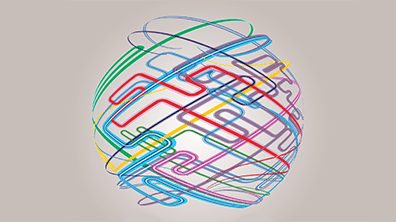Have you ever wondered why the process of trading stocks, shares or bonds involves so many intermediaries such as brokers, clearing houses, stock exchanges, custodians and asset managers? It may seem like a convoluted system for something as simple as buying and selling financial assets. However, the complexity of financial markets is primarily rooted in a fundamental concern: trust.
Settlement risk
From the perspective of sellers, trust means ensuring they receive full payment for the agreed purchase price. Buyers, meanwhile, want assurance that they will obtain unencumbered ownership of the shares or bonds they are purchasing.
In practice, the transfer of both money and share certificates is not instantaneous as cash moves from the buyer’s commercial bank account to the seller’s, and shares are re-registered in the buyer’s name. This time lag introduces uncertainty during the settlement window, sometimes lasting several days. Buyers risk surrendering rights to shares without receiving proper payment, while sellers risk making payments without obtaining ownership of the shares.
To mitigate this settlement risk, clearing houses play a critical role in financial markets, acting as intermediaries and stepping in at the inception of each trade. Clearing houses ensure that sellers receive payment for the shares sold, irrespective of whether the buyer delivers the agreed cash value. For buyers, clearing houses commit to providing the agreed-upon number of shares at the agreed price on a specified day. To manage their own net position settlement risk, clearing houses impose margin requirements and charge transaction fees.
Digital representation
Blockchain technology has the potential to revolutionise the settlement aspects of financial markets, potentially diminishing the need for clearing houses. Unlike the traditional financial system, where stocks and cash move through different rails and settlement is based on delivery versus payment (DVP), blockchain allows for the tokenisation of assets.
This means that an asset, such as a stock or cash, can be assigned a digital representation, making it possible to achieve delivery versus delivery (DVD) of assets instantaneously, thus reducing settlement risk.
So how would this work in practice? Traditional cash or deposits are transformed into digital tokens on the blockchain. These tokens represent the digital equivalent of the original funds. Similarly, share certificates are tokenised on the blockchain, creating digital representations of ownership.
These digital tokens provide a clear and immutable record of share ownership, making it easier to track, trade and transfer shares. Tokenisation of share certificates enhances transparency and reduces the administrative burden associated with paper-based share certificates.
Atomic settlement
One of the potential benefits of blockchain is that it enables ‘atomic settlement’, a concept where multiple actions or transactions such as the transfers of cash and ownership of shares are executed simultaneously or not at all. This eliminates the risk of partial or incomplete settlement, and in doing so reduces settlement risk between the buyer and seller.
Smart contracts play a pivotal role in defining the terms and conditions of a trade on the blockchain. These self-executing contracts are programmable and automatically execute predefined actions when specific conditions are met. In the settlement process, smart contracts define crucial parameters, including the cash value, the number of shares to be exchanged, the involved companies and the agreed-upon share value.
Operational risks
Despite the obvious trust benefits promised by use of blockchain technology, that’s not to say the use of tokenisation is without its risks. The immutable nature of blockchain transactions means it is crucial to ensure that data entered into the system is accurate and secure from unauthorised access or tampering.
The reliance by many financial institutions on cloud infrastructure for their blockchain solutions introduces potential vulnerabilities. Cloud services may be susceptible to security breaches, outages or data leaks, which could disrupt blockchain operations.
Choosing between private and public blockchain networks involves trade-offs. Private chains may offer greater control and security but are susceptible to single points of failure and may create silos of liquidity. Public chains, on the other hand, promote redundancy and decentralisation but come with their own set of challenges, including scalability and regulatory compliance.
On-chain vs off-chain
In certain instances, blockchain transactions might still depend on central securities depositories, such as Euroclear. Most existing financial assets are not inherently native to the blockchain. What this essentially means is that, before being tokenised, these assets were issued through conventional means, and ownership is documented through established records like share registries or commercial bank ledgers in the case of deposits.
Consequently, certain processes, like the transfer of ownership rights, may require off-chain intermediation, especially when dealing with assets that are not inherently part of the blockchain. This situation could potentially impede the technology’s ability to fundamentally transform the way asset settlements occur, as changes in ownership would have both an on-chain and an off-chain record.
Several financial institutions and exchanges are already exploring blockchain technology. The London Stock Exchange (LSE), for example, is working on an end-to-end blockchain-powered ecosystem for investors, with the aim of covering the entire lifecycle of financial assets, from issuance to trading, reconciliation and settlement.
While blockchain technology may initially focus on private markets, the long-term ambition is to create a global platform that allows participants from different jurisdictions to interact simultaneously. Already, it is poised to transform the way financial assets are traded and settled, reducing settlement risks and potentially eliminating the need for many intermediaries, such as clearing houses.
Challenges and risks exist, but the benefits of enhanced trust, efficiency and security in financial markets make blockchain a promising innovation for the future of trading and asset management.
- Reuben Wales is ICAEW’s Head of Financial Services. To find out more about ICAEW’s Financial Services Faculty and to become a member, visit the faculty’s dedicated hub.
Cyber security awareness
Each year ICAEW marks global Cyber Security Awareness month with a series of resources addressing the latest issues and how to protect your business.




